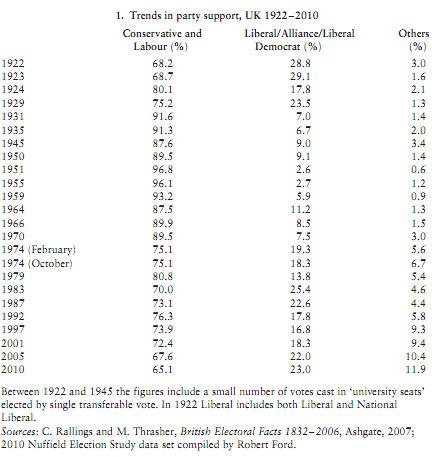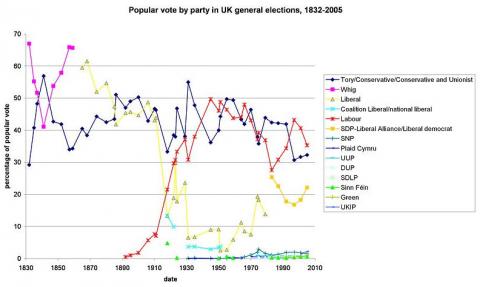AV referendum: Has UK politics historically always been a two-horse race?
Last week Intelligence2 hosted a very informative debate on the merits of AV and First Past the Post (FPTP). Full Fact attended the even, producing a leaflet outlining the most common claims made by the campaign teams, and the facts that supported or contradicted them.
One of the arguments outlined by David Aaronovich centred on the recent emergence of a multi-party and geographically fragmented voting landscape in the UK. This trend of ever fewer people voting for the Labour and Conservative 'duopoly' was not, he said, fairly reflected in the results produced by First Past the Post.
"I laid out why the First Past the Post system now was historically failing... and you may have noticed a characteristic of the discussion so far. Not one of the speakers against the system challenged my analysis of what has happened since 1955. And not one of them has even the slightest suggestion about what to do about it. In other words they want to behave as if the two party duopoly is an absolute complete constant, because the system currently forces people to go through it. And you have heard that a third of the British electorate now does not regularly vote two-party" David Aaronovitch.
He went on to argue that the fear of supporters of FPTP is that under AV, people will vote for parties other than the main two, thus challenging their ability to form governments without needing to gain the support of the majority of the electorate.
However, Michael Pinto-Duschinsky strongly disagreed with this analysis, suggesting that an analysis that used 1955 as its starting point produced a skewed picture of the UK's electoral history.
"It was always one of the lessons for statistics for trade unions organisers, that is you pick your starting point... from the most convenient point. So you pick 1955. Why pick 1955? Why not pick 1929 as your starting point, and see where you get to then?"
"It is very convenient to take that as a starting point... It is right that the two main parties have had some decline. But if one looks at a longer history, we have had other parties than the two main parties as part of our system... it is not unusual. The unusual situation historically was for a brief period after the war when you did have a very unusual form of two party dominance. And so there is a certain selectivity in your statistics." Michael Pinto-Duschinsky.
Seeking clarification on the historical trends in British elections, Full Fact went in search of the facts.
In an academic paper for Parliamentary Affairs, John Curtice looks at the historical trend for party support going back to 1922.

This historical analysis of party support in the UK shows that David Aaronovich is right to point to a trend of declining overall support for Labour and the Conservatives from a peak of 96.8 per cent in 1951 — a trend that is today not proportionally reflected in election results under FPTP.
However, Michael Pinto-Duschinsky is also making a fair point in highlighting the peak in overall support for Labour and the Conservatives in the period after World War Two.
Between 1922 and 1929 there were lower levels of support for the two main parties — coinciding with the last years of the former Liberal Party and the rise of the Labour party at the national level.
An analysis of election results prior to 1922 shows a picture of two party dominance between Conservatives (and Tories) and the Liberals (and Whigs), with Labour gaining an increasing share of the vote after the party was founded at the turn of the Twentieth Century.
The graph below shows this longer historical trend of popular vote party support.

Conclusion
Looking at historical trends in the British popular vote shows that there has been a substantial decline in support for the two-party 'duopoly' as highlighted by David Aaronovich over the second half of the Twentieth Century. This decline has been almost continuous, from a peak of 96.8 per cent in 1951 down to 65.1 per cent in 2010.
Michael Pinto-Duschinsky was also right to highlight the uniquely high support for Labour and the Conservatives following World War Two, however even before then support for the two main parties was higher than it is presently as a share of the popular vote.
The period of multi-party support that he points to in the decades before World War Two corresponds with the unique period in which the Labour Party overtook the Liberals as the second largest political party. Whether this is any less an anomalous basis for comparison than the date of 1955 chosen by Mr Aaronovitch is therefore contentious.
Certainly if we look back further towards the Nineteenth Century the dominance of two parties is sustained, albeit under a Whig and Tory 'duopoly'.
